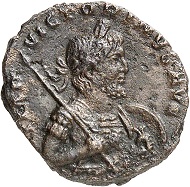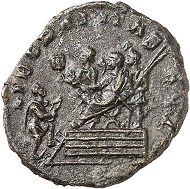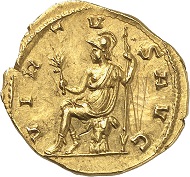15-09-2016 – 01-01-1970
Auction 41 & 42: Classical Coins and Ancient Art & The Michel Thys Collection „Gallic Empire“
450 lots featuring coins of the Gallic Empire at Jacquier’s
Postumus, Laelianus, Marius, Victorinus, Tetricus I and his son Tetricus II – these were the emperors ruling over the so called “Gallic Empire“, which, during its biggest geographical expansion wasn’t only Gaul, but also comprised Germania, Raetia, Spain and Britain. Although written records are sparse, numismatic sources are plentiful. And how plentiful the new catalog of the Paul-Francis Jacquier auction house demonstrates: It features the roughly 450 lots of the Michel Thys Collection “Coins of the Gallic Empire”; accompanied by up-to-date scholarly comments.
The collector Michel Thys.
The collector Michel Thys
Michel Thys has been collecting coins since he was 15. Everything started with a discovery on the attic of his classmate Thierry Baron d’Orjo de Marchovelette. One of his ancestors had forgotten a group of antoniniani of the 3rd century on the attic of his lavish family castle near Namur. His descendant sold 4 of them at the moderate price of 20 Belgian francs – in today’s currency about 50 cents – to Michel Thys, who in turn discovered a passion for life. In the following years he assembled rarities of the Gallic Empire in the best possible grades. What will go over the auction block at Jacquier’s Auction 42 shows how much knowledge, experience and enthusiasm the collector invested in his passion.
The main focus of the collection are antoniniani, the main denomination of this era, as well as billon denarii, which normally were struck from the dies of gold coins. Of course there are also sestertii, even though they didn’t receive as much enthusiasm from the collector. What was fascinating to Michel Thys were the many imitations of the local mints, following the model of Roman coins. At the end of the auction numerous of these imitations will be offered at collector friendly estimates.
In general, don’t let the specimens presented in the following mislead you. The auction will offer many lots in the two-digit region. Whoever is interested in coins of the Gallic Empire should not miss out on this auction!
Postumus. Denarius (billon off-metal strike from an aureus die), Cologne, fall of 261. C. 399 (150 Fr.). Elmer 174 (Aureus). Schulte 11b (this coin). From the Hoffmann Collection, Rollin & Feuardent Auction (1898), 1942. Unique. Extremely fine. Estimate: 8,000 euros.
Postumus
There are so many Postumus highlights, it’s hard to decide which ones to mention and which ones to skip. One to definitely mention is a denarius of the fall of 261, minted in Cologne and struck from the dies of the Schulte 11 aureus. On its reverse it shows Victoria riding a biga to the right and cracking the whip. Schulte mentions the specimen, which is now part of the Thys Collection, as 11b (estimate: 8,000 euros).
Lot 526: Postumus. Antoninianus, unknown mint, 263. Second known specimen. Very fine. Estimate: 4,500 euros.
Also a rarity is the extremely rare antoninianus of Postumus, displaying Victoria Postumi Augusti enthroned to the right. This is only the second known specimen (estimate: 4,500 euros).
Lot 562: Postumus. Quinarius, Cologne, 266. C – (cf. 337). Elmer 405. Very rare. Almost extremely fine. Estimate: 3,000 euros.
Let’s not forget about the quinarius of 266, also minted in Cologne. On its obverse it displays the busts of Postumus and Hercules and on its reverse stands a facing Asclepius, a type adopted from the coins of Caracalla (estimate: 3,000 euros).
Lot 571: Postumus. Medallion. Bronze off-metal strike from the die of a quadruple aureus (quaternio), Cologne, end of 267 / beginning of 268. M. Thys, Un médaillon de Postume au type HERCVLI INVICTO, BCEN 29, 1 (1992), pp. 15-18. From the Kölner Münzkabinett T. Kroha 42 (1986), 530. Unique! Almost extremely fine. Estimate: 10,000 euros.
An especially spectacular piece is the medallion struck from the dies of a quadruple aureus. The obverse shows Postumus wearing a lion skin and the obverse features Hercules restraining the Cretan Bull. This is a unique specimen, which was found in the Moselle river around 1960 (estimate: 10,000 euros).
Lot 582: Postumus. Denarius (silver off-metal strike), Cologne, beginning of 268. C. 119 (200 Fr.!). RIC 344. Elmer 493. Bastien, Travaux d’Hercule dans le monnayage de Postume, RN 1958, p. 76, 17 (this coin). From the J. du Lac Collection, Rollin & Feuardent Auction (1910), 284. Very rare. Extremely fine. Estimate: 8,000 euros.
Jacquier offers a small series of denarii, which were minted in honor of Postumus’ 4th consulate using the dies of a series of aurei featuring the labours of Hercules. All show the double portrait of Postumus and Hercules on their obverses. On the reverse Hercules carries the Erymanthian Boar (estimate: 8,000 euros), Hercules cleans out the Augean Stables (estimate: 7,000 euros), and Hercules steals the apples of the Hesperides (Estimate: 7,000 euros). The series is supplemented by an antoninianus displaying the theft of the magical girdle of Amazonian queen Hippolyta (estimate: 4,000 euros).
Lot 718: Marius. Antoninianus, Cologne. C. 2. AGK 10. Elmer 641. Extremely rare. Extremely fine. Estimate: 1,500 euros.
Marius
And these were only Postumus’ strikings. The other emperors also offer numerous show pieces. For Marius let’s take a closer look at his last and most rare striking. There are only three known pieces in existence, which were all struck from different dies. On its reverse it features Aequitas (estimate: 1,500 euros).
Lot 729: Victorinus. Denarius (bronze off-metal strike from aureus dies), Trier, ca. beginning of 270. Gilljam, Neue Abschläge der gallischen Kaiser aus einer Kölner Sammlung in: NNB 1987/3, fig. 8. Second known specimen. Almost extremely fine. Estimate: 10,000 euros.
Victorinus
Of the emperor Victorinus there are also several rarities to be discovered. For example, a denarius struck from the dies of an aureus of one emission, which was produced in the beginning of 270 in the city of Trier. The piece shows a liberalitas scene, which very likely can be associated with the bestowal of the second tribunician power. It was long considered a unique specimen. Only in 1997 a second piece was discovered (estimate: 10,000 euros).
Lot 730: Victorinus. Aureus, Trier, beginning of 270. C. 45 (600 Fr.). Elmer 679 (this coin). Schulte 9a (this coin). Calicó 3822 (this coin). From the Récamier Collection, Bourgey Auction (1925), 458. Second known specimen. Good very fine. Estimate: 15.000 euros.
Those who have been missing aurei so far will now find a piece deriving from the Récamier Collection, which was auctioned off by Bourgey in 1925. The reverse features Sol (estimate: 15,000 euros).
Lot 786: Tetricus I. Aureus, Cologne, 272. C. 202 (300 Fr.). Elmer 833 (Trier). Schulte 21a (this coin). Calicó 3916a (this coin). From the Montagu Collection, Rollin & Feuardent Auction (1896), 672 (hammer price: 920 gold francs!). Very rare. Extremely fine. Estimate: 25,000 euros.
Tetricus I and Tetricus II
Let’s close this overview with Tetricus I and his son Tetricus II. For the father, an aureus has to be mentioned. Minted in Cologne in 272, it displays Virtus on its reverse. The piece stems from the Montagu Collection and was sold for an unbelievable 920 gold francs in 1896 (estimate: 25,000 euros).
Lot 795: Tetricus I. Antoninianus, Cologne, 8th emission, 274. Normanby 1496 (1 coin). Sainte-Pallaye 7556 (1 coin). Jacquier 10 (1989), 375. 6th known specimen featuring a bust to the left. Almost extremely fine. Estimate: 2,000 euros.
Even more rare is a left facing bust of Tetricus I, which is featured on an antoninianus of 274. Until the discovery of the Normanby Find in 1985, which, among other things, included 16,000 coins of Tetricus, an antoninianus of Tetricus displaying a left facing bust was virtually unknown. Today, only 6 specimens are known (estimate: 2,000 euros).
Lot 802: Tetricus II. Denarius (bronze off-metal strike from the aureus die), Trier, 273. Unique. Extremely fine. Estimate: 8,000 euros
Not to be passed over is a denarius of Tetricus II, struck from the dies of an aureus showing the emperor’s son as Princeps Iuventutis. This is a unique specimen (estimate: 8,000 euros).
Literature
In combination to the coins, the most important numismatic literature on the Gallic Empire will be on sale.
Auction 41
Please also remember that on September 16, 2016, Auction 41 featuring ancient coins and objects will take place. As they are accustomed to with Jacquier, aficionados will find an interesting series of Greek coins including many rarities from the area of minor denominations and bronzes. In the Roman coins section especially the 3rd century is worth a look, after all, this is Paul-Francis Jacquier’s specialty. Just as ancient minor arts, of which quite a few special pieces will again be offered.
Last but not least, the offerings of numismatic literature are again surely comprehensive, which is not surprising since Paul-Francis Jacquier has been specializing in it for years.
The fully illustrated catalog may be ordered for 15 euros at Paul-Francis Jacquier, Honsellstr. 8, D-77694 Kehl am Rhein, Telephone: +07851 / 1217, or via email.
And to be able to bid online, please register in time here.
Please find the auction catalog online.
Auction 42 featuring coins of the Gallic Empire you will find at Sixbid.
Just as you will find Auction 41 featuring ancient coins, ancient art and numismatic literature at Sixbid.



























